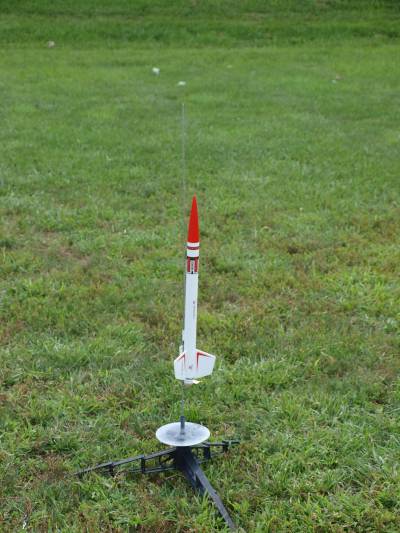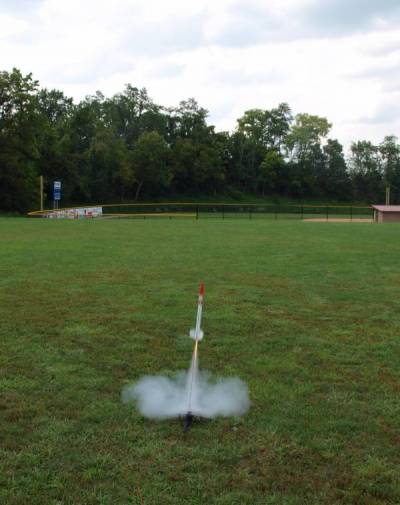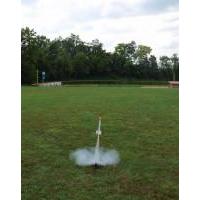| Construction Rating: | starstarstarstarstar |
| Flight Rating: | starstarstarstarstar |
| Overall Rating: | starstarstarstarstar |
| Published: | 2016-03-21 |
| Diameter: | 1.04 inches |
| Length: | 17.50 inches |
| Manufacturer: | Semroc  |
| Skill Level: | 2 |
| Style: | Downscale, Sport |
 Brief
Brief
The Estes Cherokee D was one of the first vintage kits I tried my hand at cloning when I first picked up the hobby as a BAR. Even though I'd mistakenly identified the PNC-55BB nose cone as the correct one for the project, I was quite happy with how it turned out, and if not for an unfortunate, (but spectacular,) D12 CATO, I'd likely still be flying it today. It was a great performer and a sturdy rocket, and when Carl introduced the Semroc Cherokee C I snapped up one of the first ones for use at B6-4 Field.
Components
- Nose cone
- Payload tube
- Body tube
- Nose block
- 18mm engine mount kit
- Small screw eye
- Kevlar shock cord
- Elastic shock cord
- 12" parachute kit
Construction
Finishing
Nothing complicated about this kit. After construction was finished I sprayed the whole rocket with Valspar primer, then gave it a light sanding with 220 grit sandpaper to knock off any balsa fuzz that got caught with its head out. It then got two coats of thinned Elmers Carpenters Wood Filler, followed by more sanding between each coat. When the body tube and balsa had been filled to my less-than-exacting standards I sprayed the rocket again with Valspar primer, then Valspar gloss white. The nose cone got a coat of Valspar Cherry Red and the painting was complete.
The C languished without decals for the first two flights, but with a vacation night followed by a perfect launch day (predicted) I decided to get the decals done before flight #3. All went well until disaster struck. For some reason I had decided to work on the floor in the hallway outside of my normal build room while several other projects dried just up the steps from me. I would apply a decal or two, then tend to one of the other projects, then repeat the process. I was down to my last three decals when my foot clipped the Tupperware bowl full of water that I was using for the decals. I managed to catch myself before anything personally vital was damaged, but the water dumped down on the last three uncut decals. I almost wadded them up and did without, but then I decided to see if they'd be any good once they'd dried out overnight. The next morning I cut the now dried decals apart and applied them like normal. By lunchtime they were dried and ready to fly.

Flight
First flight was in bare balsa soon after I finished construction. Since the field I fly on is a baseball field surrounded by trees, a school, a major traffic artery and a softball field that can't be accessed, I have only flown it on A8-3 motors. It's the PERFECT motor for this field as long as I keep a close eye on the breezes. (That isn't always the case, as is evidenced by the 35 or so rockets that decorate the trees, buildings, etc.) The first flight was high and straight to around 250-300'. It then rode the breeze over into the softball field, but it was before the major renovation that enclosed the structure. I was so impressed that I primed it and left it that way for almost a year and a half.
Second flight was another A8-3, this time in a quicky coat of paint, mostly to make it easier to see in the air. The flight was a carbon copy of the first, topping out at 250-300', but without the drift of the first flight which allowed for a recovery on the infield.
The most recent flight was another A8-3 and finally in full livery, (after the drama detailed above.) I began to think this rocket was charmed after this flight as the winds had been up and down all day, but were dead calm for this flight. It topped out at the same height as the previous two and recovered in short center, quite close to the pad. I'd like to try this rocket here with a B6-4, but I'm pretty sure it would be a sacrifice to the rocket gods, and I've made enough of those over the years.
Summary
Pros: Great classic look on a smaller scale. It inspired me to do BT-5 and BT-20 versions of the Cherokee.
Cons: I need a bigger field, but mine is shrinking.
 |
 |
Flights
Sponsored Ads
 |
 |













